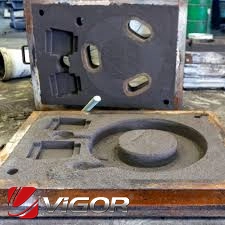
Knowledge
Advantages of Sand Casting
(1)Design Flexibility
The sand casting process empowers manufacturers with an exceptional level of creative freedom.
It allows them to create complex part geometries and intricate details that may be challenging to achieve with other manufacturing methods.
This flexibility is primarily attributed to the mold-making process, where patterns are formed in sand molds to create the desired shapes.
Another major advantage that the process offers when it comes to design flexibility is its adaptability to design modifications.
Unlike the permanent molds used in some other casting processes, sand molds can be easily altered or replaced to accommodate design changes.
The sand mold’s agility and flexibility are particularly advantageous in industries where product iterations and customization are common.
For example, consider the automotive industry, where engine components often require intricate designs to optimize performance and efficiency.
Within this industry, sand casting is often used to enable the production of complex engine blocks, cylinder heads, and intake manifolds with intricate cooling passages and precise geometries.
(2)Large Material Choice
Another significant advantage of sand casting is its compatibility with a diverse range of metals and alloys.
Sand casting offers manufacturers the flexibility to choose materials that best suit the application’s requirements.
The process can accommodate both ferrous metals, like iron and steel, and non-ferrous metals such as aluminum, copper, and brass.
Such versatility in material selection enables manufacturers to tailor the mechanical properties, corrosion resistance, and other characteristics of the final product to meet specific performance criteria.
Due to this freedom to use a variety of materials, the process is regularly used to create metal parts for a variety of applications, ranging from structural components and decorative elements to functional parts—all without compromising design integrity.
(3)Low Tooling Costs
Last but not least is sand casting’s cost-effectiveness when it comes to tooling.
Unlike some other casting processes that require expensive molds or dies, sand casting molds are typically made from inexpensive materials like sand, clay, and binders, making the process an attractive option for both prototyping and production runs.
Additionally, the process contributes to shorter lead times and faster turnaround because of the simplicity of the mold-making process it employs.
This agility enables manufacturers to quickly adapt to changing market demands and accelerate product development cycles without incurring substantial upfront costs.
Take for example the foundry industry, where rapid prototyping and low-volume production are common.
Within this environment, sand casting is often chosen to produce metal components.
Foundry managers can leverage inexpensive materials and better streamline the manufacturing processes by using this method, allowing them to offer more competitive pricing while maintaining high-quality standards.
As can be seen from the above, sand casting offers a trifecta of advantages—design flexibility, material versatility, and cost-effectiveness in tooling—making it one of the most popular casting methods for manufacturing metal components in various industries.
For more information, welcome to call us at 029 81161513 or emails at info@castings-forging.com




